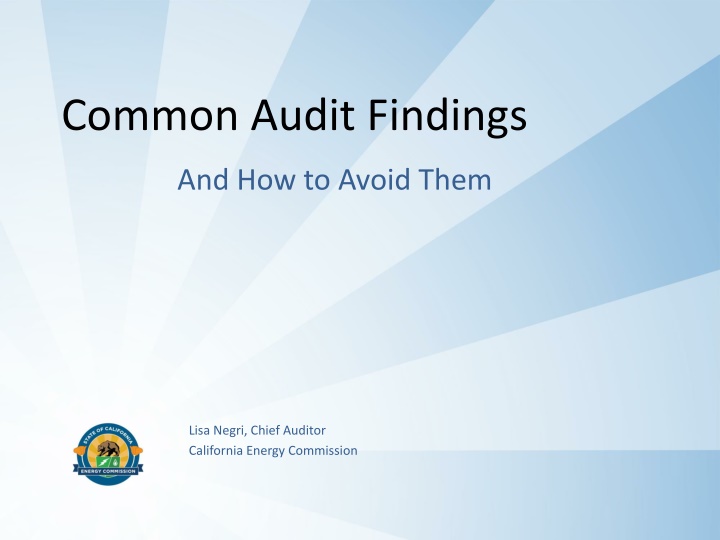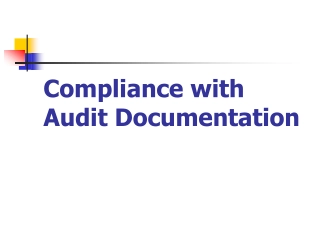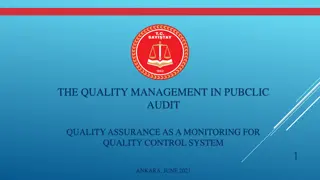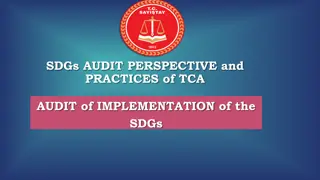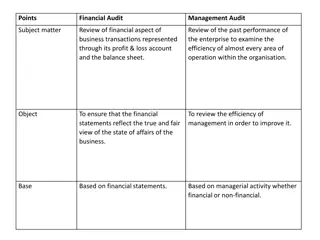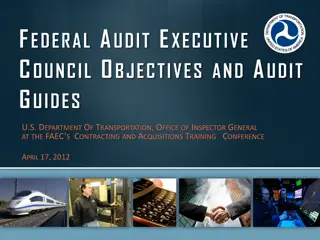Common Audit Findings
Learn about common audit findings from grant audits, including issues with indirect expenditures, labor expenses, and red flags to watch out for. Discover methods to prevent errors and ensure compliance to minimize risks during audits.
Download Presentation

Please find below an Image/Link to download the presentation.
The content on the website is provided AS IS for your information and personal use only. It may not be sold, licensed, or shared on other websites without obtaining consent from the author.If you encounter any issues during the download, it is possible that the publisher has removed the file from their server.
You are allowed to download the files provided on this website for personal or commercial use, subject to the condition that they are used lawfully. All files are the property of their respective owners.
The content on the website is provided AS IS for your information and personal use only. It may not be sold, licensed, or shared on other websites without obtaining consent from the author.
E N D
Presentation Transcript
Common Audit Findings And How to Avoid Them Lisa Negri, Chief Auditor California Energy Commission
Purpose Overview of Audits, Investigations, and Program Review Information presented is based on results from prior grant audits Goal is to help CAMS recognize red flags and work with Recipients to prevent errors Focus on grant expenditures Information is from an auditor s perspective
Indirect Expenditures Definition OMB 200.56 those costs incurred for a common or joint purpose benefitting more than one cost objective, and not readily assignable to the cost objectives specifically benefitted, without effort disproportionate to the results achieved.
Indirect Expenditures Method for the whole company Indirect Cost Pools Allocation Basis
Indirect What Can Go Wrong No Allocation Plan or documentation to support rate Allocation Plan based on estimates not actual expenditures Supported rate per the plan is less than the rate claimed Allocation method used to claim indirect is different than actual method Indirect Cost Pools contain expenditures claimed as direct costs, i.e. double billing Unallowable costs included Includes direct costs for other projects Not updated each year 100% allocated to the grant
Red Flags New company Limited staff Use of equipment expenditures in their allocation base Company is run out of owner s home, but indirect rate is high
CAM Actions During Agreement Development Ask Recipient if their indirect rate was provided by their accounting/finance office Is the rate updated each year? How long have they used this methodology, how many years data do they have? Can they support the rate if audited? Consider offering Recipient the de minimus option
Labor Expenditures Hourly Rates Calculated using payroll documentation and/or W- 2s Project Hours Strong Internal Controls All Hours Tracked on timesheets
Labor What Can Go Wrong Claimed hourly rates that are higher than the actual hourly rate Claimed hourly rates that are loaded , i.e. include fringe benefits and other costs Claimed overtime hours for salaried employees Clamed hours are not supported by timesheets Timesheets only track grant hours Missing timesheets
Red Flags Direct labor includes executive management and/or Executive Director Claimed rates are in round numbers Claimed hours are more than a standard 40 hour week for salaried employees
CAM Actions When labor is first claimed Ask Recipient is they have timesheets and if all hours are tracked? Ask if owner/executive director is tracking all hours of every day and includes notes on what was done? Ask how was hourly rate calculated? Paystubs or w-2s? If employees are paid as consultants, reallocate to subcontractor category
Fringe Benefits Fringe Benefits are the additional costs paid by the Recipient to either provide benefits to employees such as medical insurance or are required to employ staff such as payroll taxes. Unsupported fringe benefit expenditures Claimed rate not supported Including expenditures not properly classified as fringe benefits
Red Flags Rate higher than 30% New company which may not pay typical benefits such as medical or dental Employees are paid as consultants
CAM Actions Ask if company pays benefits such as medical or dental insurance? Ask how many years of data was used to calculate budgeted rate? Other than insurance, what else is included in the rate? Can the recipient support the rate if audited?
Other Expenditures Expenditures paid for equipment, materials, and subcontractors Common Findings: Incurred prior to beginning of grant Incurred, but not paid Expenditure claimed, but goods or services not received
Red Flags Equipment expenditures claimed in one large lump sum Related party subcontractors Documentation is a purchase order not an invoice Expenditures claimed but progress report/monthly calls do not support good or service was received Subcontracts not executed or T&Cs not compatible with grant agreement
CAM Actions Perform a reasonableness test by comparing project progress to claimed expenditures If IP is part of the project, ask if subcontractor is aware of requirements Ask for supporting documentation for any expenditure that appears unreasonable Follow guidelines to verify receipt of equipment
In-Kind Match Match that is provided by a 3rd party such as a subcontractor, or is based on the value of assets either donated or that are already owned by the recipient If provided by a 3rd party, should be spelled out in the contract and on invoices If based on assets owned or donated, must be able to verify Fair Market Value of the asset for the period the asset is actually used
Red Flags Donated services from a vendor who is not a project partner Donated software licenses and maintenance Subcontractor profit claimed as match
CAM Actions Review subcontracts to verify donated items are included in budget Ask recipient how they verified the fair market value of the donation, do they have documentation? If profit is being claimed, ask if recipient is paying vendor for the profit portion?
Deliverables Each grant task includes a list of products and a schedule for delivery Red Flags Recipient is falling significantly behind on schedule Recipient has not submitted permit applications Site of project has changed Change in major subcontractors Recipient is not submitting expenditure claims for long periods of time
CAM Actions Document the monthly calls Understand why delays are occurring Make sure remaining time of grant is sufficient to enable recipient to finish project and provide required data Use stop work orders if necessary If possible, perform site visits
Audit Finding Process Meeting with CAM and management to discuss finding CAM and management decide if follow audit recommendations Prepare audit resolution memo If do not want to collect questioned grant costs present to Audit Committee If audit findings include deliverable issues present to Audit Committee
Sources Grant agreement, all exhibits Office of Management and Budget Federal Cost Principles Federal Acquisition Regulations California Department of Finance Bond Accountability Guide
Questions? Hand out available for Recipients
